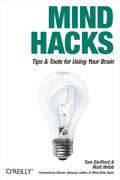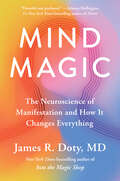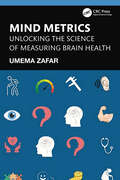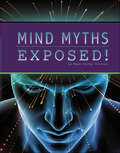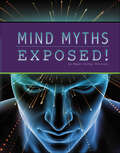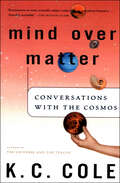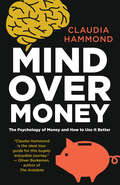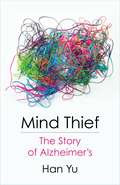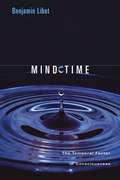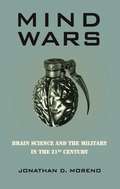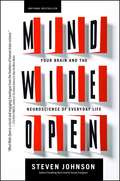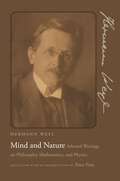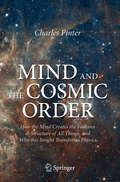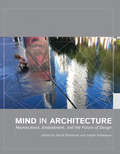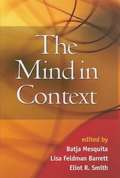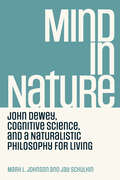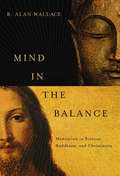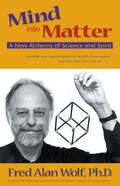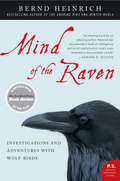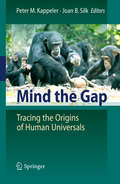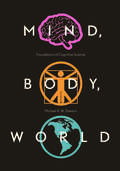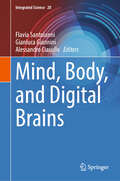- Table View
- List View
Mind Hacks: Tips & Tricks for Using Your Brain
by Tom Stafford Matt WebbThe brain is a fearsomely complex information-processing environment--one that often eludes our ability to understand it. At any given time, the brain is collecting, filtering, and analyzing information and, in response, performing countless intricate processes, some of which are automatic, some voluntary, some conscious, and some unconscious.Cognitive neuroscience is one of the ways we have to understand the workings of our minds. It's the study of the brain biology behind our mental functions: a collection of methods--like brain scanning and computational modeling--combined with a way of looking at psychological phenomena and discovering where, why, and how the brain makes them happen.Want to know more? Mind Hacks is a collection of probes into the moment-by-moment works of the brain. Using cognitive neuroscience, these experiments, tricks, and tips related to vision, motor skills, attention, cognition, subliminal perception, and more throw light on how the human brain works. Each hack examines specific operations of the brain. By seeing how the brain responds, we pick up clues about the architecture and design of the brain, learning a little bit more about how the brain is put together.Mind Hacks begins your exploration of the mind with a look inside the brain itself, using hacks such as "Transcranial Magnetic Stimulation: Turn On and Off Bits of the Brain" and "Tour the Cortex and the Four Lobes." Also among the 100 hacks in this book, you'll find:Release Eye Fixations for Faster ReactionsSee Movement When All is StillFeel the Presence and Loss of AttentionDetect Sounds on the Margins of CertaintyMold Your Body SchemaTest Your HandednessSee a Person in Moving LightsMake Events Understandable as Cause-and-EffectBoost Memory by Using ContextUnderstand Detail and the Limits of AttentionSteven Johnson, author of "Mind Wide Open" writes in his foreword to the book, "These hacks amaze because they reveal the brain's hidden logic; they shed light on the cheats and shortcuts and latent assumptions our brains make about the world." If you want to know more about what's going on in your head, then Mind Hacks is the key--let yourself play with the interface between you and the world.
Mind Magic: The Neuroscience of Manifestation and How It Changes Everything
by James R. Doty MDA deep exploration of the neuroscience behind manifestation, with a six-part plan for realizing your dreams&“Powerful and profound . . . James Doty explains how intention is manifested in the brain and offers six steps each of us can use to create the life we want.&”—Arianna Huffington, author of Thrive and The Sleep Revolution, CEO of Thrive GlobalFor decades the practice of manifestation has been widely dismissed as self-involved, materialistic pseudoscience. But as neuroscientist and recognized compassion leader Dr. James Doty reveals, manifestation introduces us to different possibilities, and it lays the groundwork for a kinder, better world.Doty grounds us in the practices that change our brain structures: attention, meditation, visualization, and compassion. This mind magic allows us to move through the world in ways that help us see clearly—reclaiming our agency, realizing our dreams, and reaching out to help others along the path.Where previous works about manifestation have focused narrowly on outward success and individual benefit, Mind Magic delivers an openhearted call to make manifestation part of a deeper contribution to healing the problems we face today.
Mind Metrics: Unlocking the Science of Measuring Brain Health
by Umema ZafarBrain health, as opposed to mental health, is a neglected phenomenon, less discovered but now capturing more attention. Currently, the concepts surrounding brain health are vague and no clear definition of this term exists. Assessing brain health early in life may offer insights into impending disruptions in brain function. If deteriorating or poor health of the brain is detected at a young age, therapeutic steps can be taken. The definition of brain health is "the preservation of optimal brain integrity and mental and cognitive function at a given age in the absence of overt brain diseases that affect normal brain function." Recently, cognitive age has been used as a better indicator of brain health called the "cognitive clock." This book reviews, for example, fMRI, EEG, and PET scans as well as measuring certain blood and CSF biomarker levels. A new noninvasive, cost-effective, and easily implemented tool for gauging brain health is introduced. This tool can be used in rural communities as well as in low- and middle-income countries (LMIC). This book focuses on the development of this new tool for brain health measurement as well as its cross-validation in diseased and healthy populations.
Mind Myths Exposed! (The Unexplained: Fact or Fiction?)
by Megan Cooley PetersonIs mind reading a real skill? What about being able to move things with just your mind? Readers will be captivated by claims of psychic powers while also learning the facts about each story. Which tales could be true and which myths are busted? Exciting, easy-to-read text and compelling images will keep struggling and reluctant readers alike flipping the pages to find out.
Mind Myths Exposed! (The Unexplained: Fact or Fiction?)
by Megan Cooley PetersonIs mind reading a real skill? What about being able to move things with just your mind? Readers will be captivated by claims of psychic powers while also learning the facts about each story. Which tales could be true and which myths are busted? Exciting, easy-to-read text and compelling images will keep struggling and reluctant readers alike flipping the pages to find out.
Mind Over Matter: Conversations with the Cosmos
by K. C. ColeK. C. Cole, the Los Angeles Times science writer and columnist, always has a fresh take on cutting-edge scientific discoveries, which she makes both understandable and very human. Reporting on physics, cosmology, mathematics, astronomy, and more, Cole's essays, culled from her popular Mind Over Matter columns, reveal the universe as simple, constant, and complex--and wholly relevant to politics, art, and every dimension of human life.
Mind Over Money: The Psychology of Cash and How to Use It Better
by Claudia HammondOn a summer evening in 1994, the two members of the band KLF burned £1 million in £50 notes in a barn on the Isle of Jura. They filmed themselves tossing the bills into the fire, and made the story public. The reaction amazed them: this act of nihilism caused a public outpouring of rage. They received death threats. And yet, if the band members had squandered their wealth away on designer clothes and sports cars, would anyone have cared?We constantly make assumptions about money. We confuse it with morality. We know we need it, and we tend to want more of it, but what we do not always appreciate are the ways it affects our minds, and emotions, and can even skew our perceptions.Mind Over Money is about what money does to us. In delightfully accessible language, Hammond explores the power of money and shows how psychology and neuroscience are providing us with some extraordinary tools for making better decisions about the way we use money.
Mind Thief: The Story of Alzheimer's
by Han YuAlzheimer’s disease, a haunting and harrowing ailment, is one of the world’s most common causes of death. Alzheimer’s lingers for years, with patients’ outward appearance unaffected while their cognitive functions fade away. Patients lose the ability to work and live independently, to remember and recognize. There is still no proven way to treat Alzheimer’s because its causes remain unknown.Mind Thief is a comprehensive and engaging history of Alzheimer’s that demystifies efforts to understand the disease. Beginning with the discovery of “presenile dementia” in the early twentieth century, Han Yu examines over a century of research and controversy. She presents the leading hypotheses for what causes Alzheimer’s; discusses each hypothesis’s tangled origins, merits, and gaps; and details their successes and failures. Yu synthesizes a vast amount of medical literature, historical studies, and media interviews, telling the gripping stories of researchers’ struggles while situating science in its historical, social, and cultural contexts. Her chronicling of the trajectory of Alzheimer’s research deftly balances rich scientific detail with attention to the wider implications. In narrating the attempts to find a treatment, Yu also offers a critical account of research and drug development and a consideration of the philosophy of aging. Wide-ranging and accessible, Mind Thief is an important book for all readers interested in the challenge of Alzheimer’s.
Mind Time: The Temporal Factor in Consciousness (Perspectives in Cognitive Neuroscience)
by Benjamin LibetOur subjective inner life is what really matters to us as human beings--and yet we know relatively little about how it arises. Over a long and distinguished career Benjamin Libet has conducted experiments that have helped us see, in clear and concrete ways, how the brain produces conscious awareness. For the first time, Libet gives his own account of these experiments and their importance for our understanding of consciousness. Most notably, Libet's experiments reveal a substantial delay--the "mind time" of the title--before any awareness affects how we view our mental activities. If all conscious awarenesses are preceded by unconscious processes, as Libet observes, we are forced to conclude that unconscious processes initiate our conscious experiences. Freely voluntary acts are found to be initiated unconsciously before an awareness of wanting to act--a discovery with profound ramifications for our understanding of free will. How do the physical activities of billions of cerebral nerve cells give rise to an integrated conscious subjective awareness? How can the subjective mind affect or control voluntary actions? Libet considers these questions, as well as the implications of his discoveries for the nature of the soul, the identity of the person, and the relation of the non-physical subjective mind to the physical brain that produces it. Rendered in clear, accessible language, Libet's experiments and theories will allow interested amateurs and experts alike to share the experience of the extraordinary discoveries made in the practical study of consciousness.
Mind Wars
by Jonathan D. Moreno"One of the most important thinkers describes the literally mind-boggling possibilities that modern brain science could present for national security." -LAWRENCE J. KORB, former US Assistant Secretary of Defense"Fascinating and frightening." -Bulletin of the Atomic ScientistsThe first book of its kind, Mind Wars covers the ethical dilemmas and bizarre history of cutting-edge technology and neuroscience developed for military applications. As the author discusses the innovative Defense Advanced Research Projects Agency (DARPA) and the role of the intelligence community and countless university science departments in preparing the military and intelligence services for the twenty-first century, he also charts the future of national security.Fully updated and revised, this edition features new material on deep brain stimulation, neuro hormones, and enhanced interrogation. With in-depth discussions of "psyops" mind control experiments, drugs that erase both fear and the need to sleep, microchip brain implants and advanced prosthetics, supersoldiers and robot armies, Mind Wars may read like science fiction or the latest conspiracy thriller, but its subjects are very real and changing the course of modern warfare.Jonathan D. Moreno has been a senior staff member for three presidential advisory commissions and has served on a number of Pentagon advisory committees. He is an ethics professor at the University of Pennsylvania and the editor-in-chief of the Center for American Progress' online magazine Science Progress.
Mind Wide Open: Your Brain and the Neuroscience of Everyday Life
by Steven JohnsonBRILLIANTLY EXPLORING TODAY'S CUTTING-EDGE BRAIN RESEARCH, MIND WIDE OPEN IS AN UNPRECEDENTED JOURNEY INTO THE ESSENCE OF HUMAN PERSONALITY, ALLOWING R<P>EADERS TO UNDERSTAND THEMSELVES AND THE PEOPLE IN THEIR LIVES AS NEVER BEFORE. Using a mix of experiential reportage, personal storytelling, and fresh scientific discovery, Steven Johnson describes how the brain works -- its chemicals, structures, and subroutines -- and how these systems connect to the day-to-day realities of individual lives. For a hundred years, he says, many of us have assumed that the most powerful route to self-knowledge took the form of lying on a couch, talking about our childhoods. The possibility entertained in this book is that you can follow another path, in which learning about the brain's mechanics can widen one's self-awareness as powerfully as any therapy or meditation or drug. <P> In Mind Wide Open, Johnson embarks on this path as his own test subject, participating in a battery of attention tests, learning to control video games by altering his brain waves, scanning his own brain with a $2 million fMRI machine, all in search of a modern answer to the oldest of questions: who am I? <P> Along the way, Johnson explores how we "read" other people, how the brain processes frightening events (and how we might rid ourselves of the scars those memories leave), what the neurochemistry is behind love and sex, what it means that our brains are teeming with powerful chemicals closely related to recreational drugs, why music moves us to tears, and where our breakthrough ideas come from. <P> Johnson's clear, engaging explanation of the physical functions of the brain reveals not only the broad strokes of our aptitudes and fears, our skills and weaknesses and desires, but also the momentary brain phenomena that a whole human life comprises. Why, when hearing a tale of woe, do we sometimes smile inappropriately, even if we don't want to? Why are some of us so bad at remembering phone numbers but brilliant at recognizing faces? Why does depression make us feel stupid? <P> To read Mind Wide Open is to rethink family histories, individual fates, and the very nature of the self, and to see that brain science is now personally transformative -- a valuable tool for better relationships and better living.
Mind and Brain: The Many-Faceted Problems
by John EcclesA collection of philosophical and scientific papers illustrating diverse viewpoints on the mind-body problem.
Mind and Life: Discussions with the Dalai Lama on the Nature of Reality (Columbia Series in Science and Religion)
by Pier Luigi LuisiScientists, philosophers and Buddhist scholars discuss the nature of reality in a book that goes inside a Mind and Life Institute conference.For over a decade, members of the Mind and Life Institute have gathered to discuss questions that are both fundamental and profound: can physics, chemistry, and biology explain the mystery of life? How do our philosophical assumptions influence science and the ethics we bring to biotechnology? And how does an ancient spiritual tradition throw new light on these questions? In Mind and Life, Pier Luigi Luisi reproduces this stimulating cross-cultural dialogue in which world-class scientists, philosophers, and Buddhist scholars develop a holistic approach to the exploration of reality. He also adds scientific background to their presentations, as well as supplementary discussions with prominent participants and attendees. Interviews with His Holiness the Karmapa, the Buddhist monk Matthieu Ricard, and the actor and longtime human rights advocate Richard Gere further enrich the material with personal viewpoints. Conversation topics range from the origin of matter to the nature of evolution, the ethics of genetic manipulation, and the question of consciousness and ethics.
Mind and Life: Discussions with the Dalai Lama on the Nature of Reality (Columbia Series in Science and Religion)
by Pier LuisiFor over a decade, a small group of scientists and philosophers-members of the Mind and Life Institute-have met regularly to explore the intersection between science and the spirit. At one of these meetings, the themes discussed were both fundamental and profound: can physics, chemistry, and biology explain the mystery of life? How do our philosophical assumptions influence science and the ethics we bring to biotechnology? And how does an ancient spiritual tradition throw new light on these questions?Pier Luigi Luisi not only reproduces this dramatic, cross-cultural dialogue, in which world-class scientists, philosophers, and Buddhist scholars develop a holistic approach to the scientific exploration of reality, but also adds scientific background to their presentations, as well as supplementary discussions with prominent participants and attendees. Interviews with His Holiness the Karmapa, the Buddhist monk Matthieu Ricard, and the actor and longtime human rights advocate Richard Gere take the proceedings into new directions, enriching the material with personal viewpoints and lively conversation about such topics as the origin of matter, the properties of cells, the nature of evolution, the ethics of genetic manipulation, and the question of consciousness and ethics. A keen study of character, Luisi incorporates his own amusing observations into this fascinating dialogue, painting a very human portrait of some of our greatest-and most intimidating-thinkers. Deeply textured and cleverly crafted, Mind and Life is an excellent opportunity for any reader to join in the debate surrounding this cutting-edge field of inquiry.
Mind and Nature: Selected Writings on Philosophy, Mathematics, and Physics
by Hermann WeylHermann Weyl (1885-1955) was one of the twentieth century's most important mathematicians, as well as a seminal figure in the development of quantum physics and general relativity. He was also an eloquent writer with a lifelong interest in the philosophical implications of the startling new scientific developments with which he was so involved. Mind and Nature is a collection of Weyl's most important general writings on philosophy, mathematics, and physics, including pieces that have never before been published in any language or translated into English, or that have long been out of print. Complete with Peter Pesic's introduction, notes, and bibliography, these writings reveal an unjustly neglected dimension of a complex and fascinating thinker. In addition, the book includes more than twenty photographs of Weyl and his family and colleagues, many of which are previously unpublished. Included here are Weyl's exposition of his important synthesis of electromagnetism and gravitation, which Einstein at first hailed as "a first-class stroke of genius"; two little-known letters by Weyl and Einstein from 1922 that give their contrasting views on the philosophical implications of modern physics; and an essay on time that contains Weyl's argument that the past is never completed and the present is not a point. Also included are two book-length series of lectures, The Open World (1932) and Mind and Nature (1934), each a masterly exposition of Weyl's views on a range of topics from modern physics and mathematics. Finally, four retrospective essays from Weyl's last decade give his final thoughts on the interrelations among mathematics, philosophy, and physics, intertwined with reflections on the course of his rich life.
Mind and the Cosmic Order: How the Mind Creates the Features & Structure of All Things, and Why this Insight Transforms Physics
by Charles PinterThe topic of this book is the relationship between mind and the physical world. From once being an esoteric question of philosophy, this subject has become a central topic in the foundations of quantum physics. The book traces this story back to Descartes, through Kant, to the beginnings of 20th Century physics, where it becomes clear that the mind-world relationship is not a speculative question but has a direct impact on the understanding of physical phenomena. The book’s argument begins with the British empiricists who raised our awareness of the fact that we have no direct contact with physical reality, but it is the mind that constructs the form and features of objects. It is shown that modern cognitive science brings this insight a step further by suggesting that shape and structure are not internal to objects, but arise in the observer. The author goes yet further by arguing that the meaningful connectedness between things — the hierarchical organization of all we perceive — is the result of the Gestalt nature of perception and thought, and exists only as a property of mind. These insights give the first glimmerings of a new way of seeing the cosmos: not as a mineral wasteland but a place inhabited by creatures.
Mind in Architecture: Neuroscience, Embodiment, and the Future of Design (Mit Press Ser.)
by Juhani Pallasmaa Sarah RobinsonLeading neuroscientists and architects explore how the built environment affects our behavior, thoughts, emotions, and well-being.Although we spend more than ninety percent of our lives inside buildings, we understand very little about how the built environment affects our behavior, thoughts, emotions, and well-being. We are biological beings whose senses and neural systems have developed over millions of years; it stands to reason that research in the life sciences, particularly neuroscience, can offer compelling insights into the ways our buildings shape our interactions with the world. This expanded understanding can help architects design buildings that support both mind and body. In Mind in Architecture, leading thinkers from architecture and other disciplines, including neuroscience, cognitive science, psychiatry, and philosophy, explore what architecture and neuroscience can learn from each other. They offer historical context, examine the implications for current architectural practice and education, and imagine a neuroscientifically informed architecture of the future.Architecture is late in discovering the richness of neuroscientific research. As scientists were finding evidence for the bodily basis of mind and meaning, architecture was caught up in convoluted cerebral games that denied emotional and bodily reality altogether. This volume maps the extraordinary opportunity that engagement with cutting-edge neuroscience offers present-day architects.ContributorsThomas D. Albright, Michael Arbib, John Paul Eberhard, Melissa Farling, Vittorio Gallese, Alessandro Gattara, Mark L. Johnson, Harry Francis Mallgrave, Iain McGilchrist, Juhani Pallasmaa, Alberto Pérez-Gómez, Sarah Robinson
Mind in Context
by Lisa Barrett Batja MesquitaMost psychology research still assumes that mental processes are internal to the person, waiting to be expressed or activated. This compelling book illustrates that a new paradigm is forming in which contextual factors are considered central to the workings of the mind. Leading experts explore how psychological processes emerge from the transactions of individuals with their physical, social, and cultural environments. The volume showcases cutting-edge research on the contextual nature of such phenomena as gene expression, brain networks, the regulation of hormones, perception, cognition, personality, knowing, learning, and emotion.
Mind in Nature: John Dewey, Cognitive Science, and a Naturalistic Philosophy for Living
by Jay Schulkin Mark L. JohnsonA dialogue between contemporary neuroscience and John Dewey&’s seminal philosophical work Experience and Nature, exploring how the bodily roots of human meaning, selfhood, and values provide wisdom for living.The intersection of cognitive science and pragmatist philosophy reveals the bodily basis of human meaning, thought, selfhood, and values. John Dewey's revolutionary account of pragmatist philosophy Experience and Nature (1925) explores humans as complex social animals, developing through ongoing engagement with their physical, interpersonal, and cultural environments. Drawing on recent research in biology and neuroscience that supports, extends, and, on occasion, reformulates some of Dewey's seminal insights, embodied cognition expert Mark L. Johnson and behavioral neuroscientist Jay Schulkin develop the most expansive intertwining of Dewey's philosophy with biology and neuroscience to date.The result is a positive, life-affirming understanding of how our evolutionary and individual development shapes who we are, what we can know, where our deepest values come from, and how we can cultivate wisdom for a meaningful and intelligent life.
Mind in the Balance: Meditation in Science, Buddhism, and Christianity (Columbia Series in Science and Religion)
by B. Alan WallaceBy establishing a dialogue in which the meditative practices of Buddhism and Christianity speak to the theories of modern philosophy and science, B. Alan Wallace reveals the theoretical similarities underlying these disparate disciplines and their unified approach to making sense of the objective world. Wallace begins by exploring the relationship between Christian and Buddhist meditative practices. He outlines a sequence of meditations the reader can undertake, showing that, though Buddhism and Christianity differ in their belief systems, their methods of cognitive inquiry provide similar insight into the nature and origins of consciousness. From this convergence Wallace then connects the approaches of contemporary cognitive science, quantum mechanics, and the philosophy of the mind. He links Buddhist and Christian views to the provocative philosophical theories of Hilary Putnam, Charles Taylor, and Bas van Fraassen, and he seamlessly incorporates the work of such physicists as Anton Zeilinger, John Wheeler, and Stephen Hawking. Combining a concrete analysis of conceptions of consciousness with a guide to cultivating mindfulness and profound contemplative practice, Wallace takes the scientific and intellectual mapping of the mind in exciting new directions.
Mind into Matter: A New Alchemy of Science and Spirit
by Fred Alan WolfA physicist examines ideas from medieval alchemy and contemporary science to explore the connection between mind and matter.Alchemists of old attempted to make sense of the universe—to discover the connection between mind and matter. Some of today’s scientists, in particular quantum physicists, are doing the same. In this contribution to the study of consciousness, physicist Fred Alan Wolf reveals what he calls the “new alchemy” —a melding of the ideas of the old alchemists and the new scientists to reach a fuller understanding of mind and matter.An elegant book with short, stand-alone chapters, each framed by an alchemical symbol and its definition, Mind into Matter is thought provoking for scientists and lay people alike.Praise for Mind into Matter“I consider Fred Alan Wolf one of the most important pioneers in the field of consciousness. This book could change the way you perceive the world.” —Deepak Chopra, MD, FACP, author of How to Know God“Once again, physicist Fred Alan Wolf takes us on a magical mystery tour into the adventure land of science and spirit. . . . Both enthralling and energizing.” —Michael Toms, cofounder, host, producer of New Dimensions Radio“How refreshing to have a scientist put the emphasis on the individual where it belongs! Wolf has written a glorious entertainment for the mind that matters.” —Kenneth Ring, PhD, author of Lessons from the Light“[A]llows readers to look at their own inner mechanism and better understand the consciousness which gives them life and makes them aware of the outer world of forms and phenomena in which they live.” —Glen P. Kezwer, Ph.D., physicist, author of Meditation, Oneness and Physics
Mind of the Raven: Investigations and Adventures with Wolf-Birds (P. S. Series)
by Bernd HeinrichHeinrich involves us in his quest to get inside the mind of the raven. But as animals can only be spied on by getting quite close, Heinrich adopts ravens, thereby becoming a "raven father," as well as observing them in their natural habitat. He studies their daily routines, and in the process, paints a vivid picture of the ravens' world. At the heart of this book are Heinrich's love and respect for these complex and engaging creatures, and through his keen observation and analysis, we become their intimates too.Heinrich's passion for ravens has led him around the world in his research. Mind of the Raven follows an exotic journey--from New England to Germany, and from Montana to Baffin Island in the high Arctic--offering dazzling accounts of how science works in the field, filtered through the eyes of a passionate observer of nature. Each new discovery and insight into raven behavior is thrilling to read, at once lyrical and scientific.
Mind the Gap
by Joan Silk Peter KappelerWhat makes us human? What made us become the way we are? One way to answer these questions is to identify the traits that all humans share, traits that are universal features of all human societies. Another way to do so is to ask how humans differ from other species, particularly from our closest relatives, the nonhuman primates. The contributors to this book pursue both approaches, in an effort to understand how evolution has shaped modern human behavior and societies.
Mind, Body, World: Foundations of Cognitive Science
by Michael R. DawsonCognitive science arose in the 1950s when it became apparent that a number of disciplines, including psychology, computer science, linguistics, and philosophy, were fragmenting. Perhaps owing to the field’s immediate origins in cybernetics, as well as to the foundational assumption that cognition is information processing, cognitive science initially seemed more unified than psychology. However, as a result of differing interpretations of the foundational assumption and dramatically divergent views of the meaning of the term information processing, three separate schools emerged: classical cognitive science, connectionist cognitive science, and embodied cognitive science. Examples, cases, and research findings taken from the wide range of phenomena studied by cognitive scientists effectively explain and explore the relationship among the three perspectives. Intended to introduce both graduate and senior undergraduate students to the foundations of cognitive science, Mind, Body, World addresses a number of questions currently being asked by those practicing in the field: What are the core assumptions of the three different schools? What are the relationships between these different sets of core assumptions? Is there only one cognitive science, or are there many different cognitive sciences? Giving the schools equal treatment and displaying a broad and deep understanding of the field, Dawson highlights the fundamental tensions and lines of fragmentation that exist among the schools and provides a refreshing and unifying framework for students of cognitive science.
Mind, Body, and Digital Brains (Integrated Science #20)
by Flavia Santoianni Alessandro Ciasullo Gianluca GianniniThis book—Mind, Body, and Digital Brains—focuses on both theoretical and empirical issues and joins contributions from different disciplines, concepts, and sensibilities, bringing together scholars from fields that at first glance may appear different—Neuroscience and Cognitive Neuroscience; Robotics, Computer Science, Deep Learning, and Information Processing Systems; Education, Philosophy, Law, and Psychology. All these research fields are held together by the very object to be discussed: a broad, articulate, and polyphonic reflection on the status of theories and fields of application of Digital Technologies and Artificial Intelligence, seen from the perspective of the digital mind, digital body, and digital brain. Scientific and humanistic issues will be considered through an interdisciplinary point of view, with the purpose of deepening emerging trends about various disciplines. This book offers a framework for different perspectives and, at the same time, a platform for discussion aimed not only at experts, but also at a non-specialist public interested in the digital revolution. The digital revolution is emerging from the intertwining of ethical, philosophical, and technological aspects, which concern several general issues as cooperation, law, and environment, but also specialized as cybersecurity or algorithmic citizenship. More questions arise, concerning which opportunities and risks are associated with the new scenarios, what idea of humanity is emerging from the increasingly widespread use of Artificial Intelligence technologies, and what idea of integrated science should we promote to accompany the ongoing transformations.
